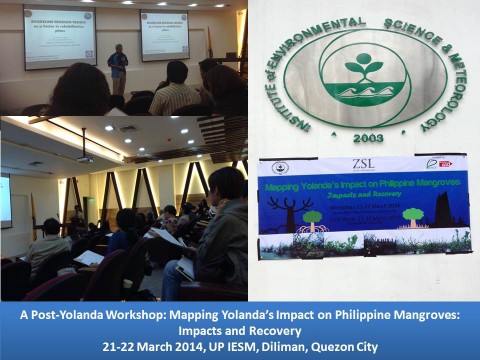Mapping Yolanda’s Impact on Philippine Mangroves: Impacts and Recovery

Young Public Managers and Developers: #NetizensInAction on Climate Change
November 28, 2016
Integrating DRR and Climate Adaptation Actions into Sustainable Dev’t After Yolanda
November 28, 2016The OML Center joined the Post-Yolanda Workshop on “Mapping Yolanda’s Impact on Philippine Mangroves: Impacts and Recovery” organized by the Zoological Society of London (ZSL) and the University of the Philippines’ Institute of Environmental Science and Meteorology (IESM). The two-day workshop was held at the IESM Auditorium in UP Diliman on 21-22 March 2014. It was followed by a field trip to Yolanda-affected areas in Leyte.
The workshop presented the latest findings from research on the impacts of Yolanda on mangrove forests at national and local scales. The workshop was participated by representatives from key national and international academic and research organizations, government agencies and NGOs.
There were three paper presentations on the Physical Assessment of Typhoon Yolanda Impact – two of which from UP Marine Science Institute’s Dr. Cesar L. Villanoy and Dr. Fernando P. Siringan, and one from Dr. Leoncio Amadore of UP IESM. The first presentation, given by Dr. Villanoy, provided a framework for post-Yolanda assessments and provided an understanding on the development of the storm surge in San Pedro Bay. In the same vein, Dr. Amadore presented observations on the storm surge development at Basey, Western Samar and provided a framework for rehabilitation integrating climate change adaptation and disaster risk reduction. Moreover, Dr. Siringan showed the shoreline erosion trends in along the Eastern coasts of Tacloban, Palo and other parts of Leyte and how shoreline erosion can be an important factor to consider in the rehabilitation of these areas.
Presentations on the assessment of mangrove areas after Yolanda were given by Dr. Jurgenne Primavera (ZSL), Forester Dexter Cabahug (B+Wiser) and Dr. Rene Rollon (UP-IESM). The presentations focused on pre- and post- damage assessments of mangrove ecosystems in Yolanda affected areas particularly in Panay Island, Tacloban and Palo in Leyte, and in Guiuan, Northern Leyte Gulf and Matarinao Bay, Eastern Samar. A paper on mapping and monitoring the Philippines’ mangrove forests after Yolanda by Dr. Jordan Long of the USGS was also presented by Dr. Jurgenne Primavera.
Second day of the workshop was devoted to answering two research questions: (1) What are the data gaps to evaluate impacts of Typhoon Yolanda on mangrove and beach forests?; and (2) What are the possible rehabilitation strategies to address impacts of Typhoon Yolanda on mangrove and beach forests.
A report will be produced from the workshop and will contain a compilation of available assessments and data on the effects of Yolanda on mangrove forests; action plan for rehabilitation using standardized, science-based methods; management information and guidance (e.g., on priorities, challenges and opportunities, methods) to decision-makers (e.g., DENR and other government agencies), donor organizations (e.g., Philippine Disaster Recovery Foundation, USAID) and NGOs in the forefront of Yolanda recovery.

